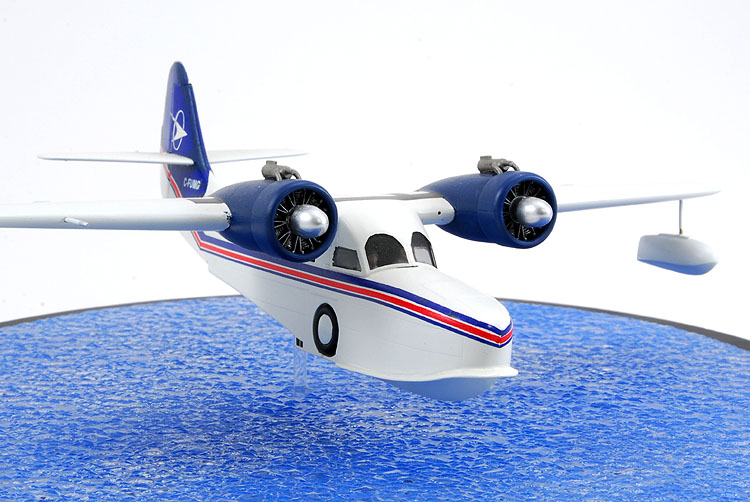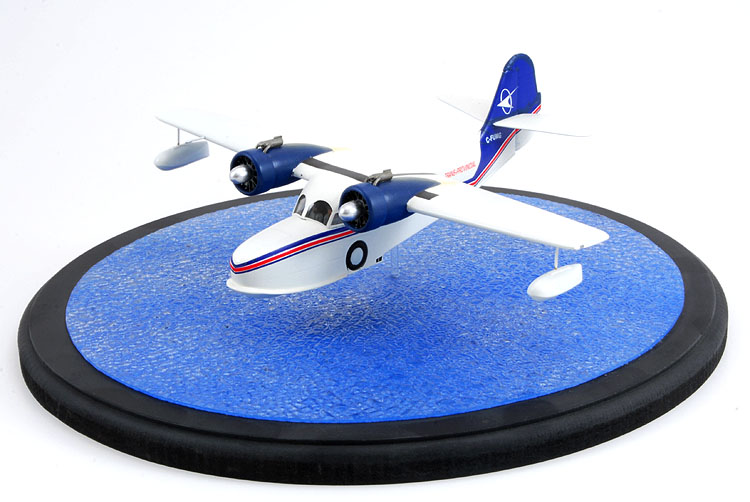

A couple simple modifications can turn a military Goose into a civilian bush plane.
Kit:
Aftermarket:
Date:
Sword (SW722011SE)
Draw Decals decals (72-Goose-6)
-
Immortalized in Jimmy Buffet’s first novel, “Where is Joe Merchant?” and in the 1982-1983 television series “Tales of the Golden Monkey” the Goose is probably the most famous, and
recognized of all of Grumman’s amphibious planes.
Although history books would have us think that all of North America spent the Great Depression riding from town to town searching for work, eating out of soup lines, and fighting to
survive, they fail to mention that many of those who had money, kept it. Many of the richest of the richest Americans were in the North-eastern States. Grumman Aircraft Engineering
Corp. was in a perfect position to benefit. The G-21 was designed as an airliner to fly these rich business men from their (and Grumman’s) home on Long Island to the financial
district of New York City, it would now be called a corporate, or business plane.
Debuting in 1937, the G-21 featured many typical Grumman traits; extremely rugged, all metal construction, and a narrow, manually retractable landing gear that also appeared in their
FF-1 biplane and F4F Wildcats. Its deep hull/fuselage was ideally suited to accommodate 10 passengers, or a bulky load of freight. Configured as a flying yacht, it usually seated two
or three, a bar and small toilet.
In 1938, the US military started showing interest. Although the Navy did buy quite a few (JRF), it was the Army Air Force that placed the first orders (OA-9). The US Coast Guard, RAF
and RCAF followed with orders of their own. It was the RAF who, following their standard, assigned it the name Goose.
Although only 345 Goose were produced, their non-combat role, and original civilian design made them ideal planes for many post-war airlines. Through the years, several modifications
have been offered, the most popular being retractable wingtip floats. A turbo-prop conversion was also offered.
In Canada, Gooses served as corporate transports, bush planes and commuter airliners, mostly in Ontario and BC.
See this story to read about building this model.
Digging through my box of wooden bases, I found one big enough for my Goose and spray painted it black. Normal household spray paint was perfect (and cheaper) for this.
To make the waves, I started by taking a piece of clear plastic window covering. I believe this is sold in sheets at home improvement stores under the name of ‘cracked ice.’ I drew a
circle on the plastic, trimmed the excess off with a band-saw and smoothed it with a belt-sander.
To colour the water I took a can of Testor’s blue spray paint and lightly dusted the backside with paint. I didn’t go for complete coverage, as I wanted the wooden base’s black
paint to show through and create the illusion of waves and troughs. After it was dry, I applied white glue to the ‘water’ and glued it to the wooden base.
Two holes were drilled - one into the wooden base, and another into the model. A clear plastic rod, about two inches in length was glued into the base. This way, I can remove my
Goose from the base should I go traveling.
It's simple but I think this base does enough to convey my Goose is about to land on some water.

The base is simple, but it conveys the message that this is a seaplane.